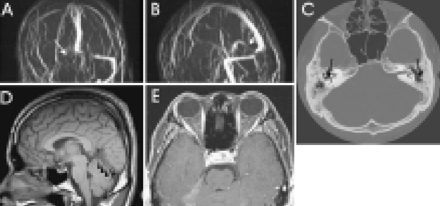J Clin Neurol.
2006 Mar;2(1):70-73. 10.3988/jcn.2006.2.1.70.
Cluster-like Headache Secondary to Cerebral Venous Thrombosis
- Affiliations
-
- 1Department of Neurology, Seoul National University, College of Medicine, Clinical Research Institute, Seoul National University Hospital, Seoul, Korea. kimmanho@snu.ac.kr
- 2Department of Neurology, Eulji University School of Medicine, Seoul, Korea.
- KMID: 2287706
- DOI: http://doi.org/10.3988/jcn.2006.2.1.70
Abstract
- Cluster headache (CH) is considered a primary headache syndrome. However, symptomatic cases that resemble CH have also been reported. A patient with cerebral venous thrombosis presented with ipsilateral frontal pain accompanied by ophthalmoparesis, nasal congestion, and lacrimation. The patient's headache showed a dramatic response to oxygen. He experienced no further cluster-like headaches after treatment with an anticoagulant. This case suggests the possible role of venous stasis of the cavernous sinus in cluster-like headache.
MeSH Terms
Figure
Reference
-
1. Moskcowitz MA. Cluster headache: evidence for a pathophysiologic focus in the superior pericarotid cavernous sinus plexus. Headache. 1988. 28:584–586.
Article2. Hannerz J, Ericson K, Bergstrand G. Orbital phlebography in patients with cluster headache. Cephalalgia. 1987. 7:207–211.
Article3. Hannerz J. A case of parasellar meningioma mimicking cluster headache. Cephalalgia. 1989. 9:265–269.
Article4. Todo T, Inoya H. Sudden appearance of a mycotic aneurysm of the intracavernous carotid artery after symptoms resembling cluster headache: case report. Neurosurgery. 1991. 29:594–599.
Article5. May A, Bahra A, Buchel C, Frackowiak RSJ, Goadsby PJ. Hypothalamic activation in cluster attacks. Lancet. 1998. 352:275–278.6. Leone M, Bussone G. A review of hormonal findings in cluster headache. Evidence for hypothalamic involvement. Cephalalgia. 1993. 13:309–317.
Article7. Frishberg BM. Neuroimaging in presumed primary headache disorders. Semin Neurol. 1997. 17:373–382.
Article8. Ameri A, Bousser MG. Cerebral venous thrombosis. Neurol Clin. 1992. 10:87–111.
Article9. Afra J, Cecchini AP, Schoenen J. Craniometric measures in cluster headache patients. Cephalalgia. 1998. 18:143–145.
Article10. Hannerz J, Jogestrand T. Chronic cluster headache: provocation with carbon dioxide breathing and nitroglycerin. Headache. 1996. 36:174–177.
Article
- Full Text Links
- Actions
-
Cited
- CITED
-
- Close
- Share
- Similar articles
-
- Parasellar Meningioma Mimicking Cluster Headache Treated with Novalis Stereotactic Radiosurgery
- Cerebral Venous Thrombosis Complicated by Intracranial Hypotension
- Deep Cerebral Venous Thrombosis Showing Parkinsonism such as Micrographia, Hypophonia and Bradykinesia
- A Case of Deep Cerebral Venous Thrombosis Associated with Iron Deficiency Anemia
- A Case of Leptomeningeal Metastasis Associated with Cerebral Venous Thrombosis



